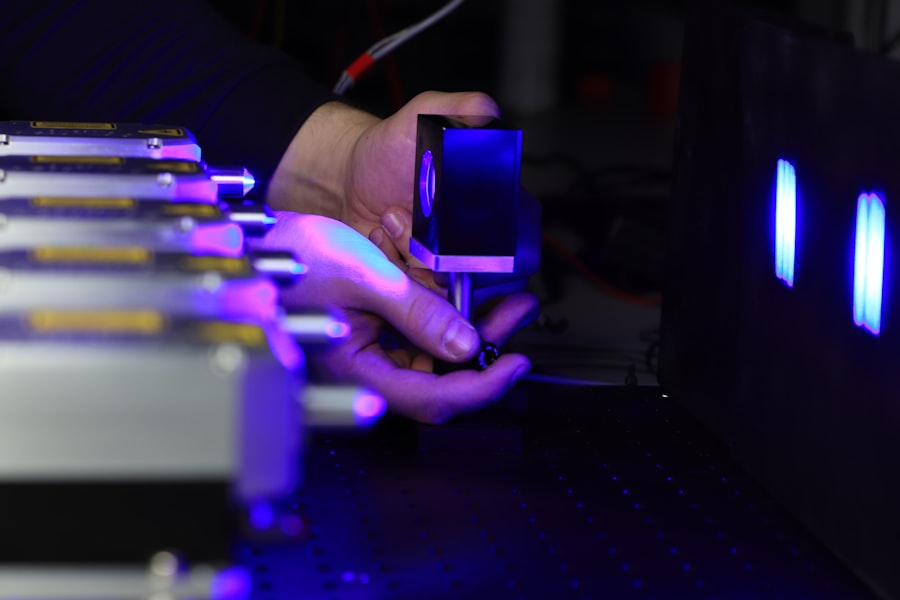Laser hair removal is a popular cosmetic procedure that utilizes concentrated beams of light to target and eliminate unwanted hair. The technology behind this method is based on the principle of selective photothermolysis, where the laser energy is absorbed by the pigment in the hair follicles. This absorption leads to the destruction of the follicle, inhibiting future hair growth.
As you consider this option, it’s essential to understand how the process works and what to expect during your treatment sessions. During a typical laser hair removal session, a handheld device emits laser light onto the skin’s surface. The sensation can vary from person to person, often described as a mild snapping or tingling feeling.
Many clinics offer cooling devices or topical anesthetics to enhance comfort during the procedure. The effectiveness of laser hair removal largely depends on the contrast between your skin tone and hair color; darker hair on lighter skin tends to yield the best results. However, advancements in technology have made it possible for individuals with various skin tones and hair colors to benefit from this treatment.
Key Takeaways
- Laser hair removal uses concentrated light to target and destroy hair follicles, resulting in long-term hair reduction.
- The frequency of laser hair removal sessions varies depending on the individual’s hair growth cycle and the area being treated.
- Potential risks and side effects of laser hair removal include skin irritation, redness, and changes in skin pigmentation.
- Safety considerations for repeated treatments include avoiding sun exposure and using sunscreen to protect the skin.
- Skin type and sensitivity play a role in determining the effectiveness and safety of laser hair removal treatments.
- Consultation with a professional is essential to assess the individual’s suitability for laser hair removal and to discuss expectations and potential outcomes.
- Post-treatment care and maintenance may include avoiding hot showers, using gentle skincare products, and protecting the skin from sun exposure.
- Alternative hair removal methods such as waxing, shaving, and depilatory creams may be considered for those who are not suitable candidates for laser hair removal.
Frequency of Laser Hair Removal Sessions
When embarking on your laser hair removal journey, understanding the frequency of sessions is crucial for achieving optimal results. Typically, you will need multiple treatments spaced several weeks apart to effectively target hair in different growth cycles. Hair grows in three phases: anagen (growth), catagen (transitional), and telogen (resting).
Most practitioners recommend an initial series of six to eight sessions, spaced about four to six weeks apart. This schedule allows for the maximum number of hairs to be treated during their active growth phase.
After completing the initial series, you may require maintenance sessions every six months to a year, depending on your individual hair growth patterns and hormonal influences. Keeping track of your progress and discussing any changes with your practitioner will help you determine the best frequency for your ongoing treatments.
Potential Risks and Side Effects
While laser hair removal is generally considered safe, it’s important to be aware of potential risks and side effects associated with the procedure. Common side effects include temporary redness, swelling, and mild discomfort in the treated area. These symptoms usually subside within a few hours to a couple of days.
However, some individuals may experience more pronounced reactions, such as blistering or changes in skin pigmentation, particularly if they have darker skin tones. In rare cases, you might encounter more severe complications, such as scarring or infection. To minimize these risks, it’s essential to choose a qualified practitioner who uses FDA-approved equipment and follows proper safety protocols.
Additionally, discussing your medical history and any skin sensitivities with your provider can help tailor the treatment plan to suit your needs while reducing the likelihood of adverse effects.
Safety Considerations for Repeated Treatments
| Treatment Type | Safety Considerations |
|---|---|
| Medication | Monitor for potential side effects and drug interactions |
| Physical Therapy | Ensure proper technique to prevent injury |
| Surgery | Assess risks of anesthesia and post-operative complications |
As you consider repeated laser hair removal treatments, safety should always be a top priority. One of the most critical factors is ensuring that you are receiving treatments from a licensed and experienced professional. This not only enhances your safety but also increases the likelihood of achieving satisfactory results.
A skilled practitioner will assess your skin type, hair color, and medical history before recommending a personalized treatment plan. Another important safety consideration is adhering to pre- and post-treatment guidelines provided by your practitioner. This may include avoiding sun exposure, tanning beds, and certain skincare products before your sessions.
Following these recommendations can significantly reduce the risk of complications and ensure that your skin remains healthy throughout the process. Regular follow-ups with your provider will also help monitor your progress and address any concerns that may arise during your treatment journey.
Skin Type and Sensitivity
Your skin type and sensitivity play a significant role in determining how well you respond to laser hair removal treatments. Different skin types react differently to laser energy; for instance, individuals with lighter skin tones typically experience fewer side effects compared to those with darker skin tones. This is due to the contrast between the pigment in the hair and the surrounding skin, which affects how effectively the laser can target the hair follicles without damaging the skin.
If you have sensitive skin or a history of adverse reactions to cosmetic procedures, it’s essential to communicate this with your practitioner during your consultation. They may recommend specific pre-treatment measures or alternative methods that are better suited for your skin type. Additionally, patch testing on a small area of skin can help gauge how your body will react to the treatment before committing to full sessions.
Consultation with a Professional

Before embarking on your laser hair removal journey, scheduling a consultation with a qualified professional is crucial. During this initial meeting, you will have the opportunity to discuss your goals, expectations, and any concerns you may have regarding the procedure. A knowledgeable practitioner will conduct a thorough assessment of your skin type, hair color, and medical history to determine if you are a suitable candidate for laser hair removal.
This consultation is also an excellent time to ask questions about the technology used in the clinic, the experience of the staff, and what you can expect during and after treatment. Understanding the potential outcomes and limitations of laser hair removal will help set realistic expectations for your results. Moreover, a reputable provider will take the time to explain their approach to safety and aftercare, ensuring that you feel confident moving forward with your decision.
Post-Treatment Care and Maintenance
After undergoing laser hair removal sessions, proper post-treatment care is essential for achieving optimal results and minimizing side effects. Immediately following your treatment, you may notice some redness or swelling in the treated area; this is normal and should subside within a few hours. To soothe any discomfort, applying a cool compress or aloe vera gel can be beneficial.
In the days following your treatment, it’s crucial to avoid sun exposure and tanning beds, as your skin will be more sensitive than usual. Wearing sunscreen with a high SPF is recommended to protect the treated areas from UV damage. Additionally, refrain from using harsh skincare products or exfoliants for at least a week post-treatment to allow your skin to heal properly.
Regular follow-up appointments with your practitioner will help monitor your progress and address any concerns that may arise during your recovery.
Alternative Hair Removal Methods
While laser hair removal offers many benefits, it’s not the only option available for managing unwanted hair. Various alternative methods exist, each with its own set of advantages and disadvantages. For instance, shaving is one of the most common methods due to its convenience and affordability; however, it requires frequent maintenance and can lead to irritation or ingrown hairs.
Waxing is another popular choice that provides longer-lasting results than shaving but can be painful and may cause skin sensitivity in some individuals. Depilatory creams offer a chemical solution for hair removal but can also lead to allergic reactions or irritation if not used correctly. Ultimately, choosing the right method depends on your personal preferences, pain tolerance, budget, and desired results.
In conclusion, understanding laser hair removal involves considering various factors such as session frequency, potential risks, safety measures for repeated treatments, skin type sensitivity, professional consultations, post-treatment care, and alternative methods available. By educating yourself on these aspects and working closely with a qualified practitioner, you can make informed decisions that align with your goals for smooth, hair-free skin.
If you are considering getting laser hair removal treatments every 3 weeks, you may want to read the article on inlaserhairremoval.com that discusses the benefits and potential risks of frequent sessions. This article provides valuable information on how often you should schedule your laser hair removal appointments to achieve the best results without causing harm to your skin. For more insights on laser hair removal and other related topics, visit inlaserhairremoval.com or check out their sample page at inlaserhairremoval.com/sample-page.
FAQs
What is laser hair removal?
Laser hair removal is a cosmetic procedure that uses a concentrated beam of light (laser) to remove unwanted hair. The light is absorbed by the pigment in the hair follicles, which damages the follicle and inhibits future hair growth.
How often can I do laser hair removal?
The frequency of laser hair removal treatments can vary depending on the individual and the area being treated. Typically, treatments are spaced 4-6 weeks apart to target hair in different stages of growth.
Can I do laser hair removal every 3 weeks?
While it is possible to do laser hair removal every 3 weeks, it is not recommended. The hair growth cycle typically requires a longer interval between treatments to effectively target hair in different stages of growth.
What are the potential risks of doing laser hair removal too frequently?
Doing laser hair removal too frequently can increase the risk of skin irritation, burns, and changes in skin pigmentation. It can also reduce the effectiveness of the treatment in targeting hair in different stages of growth.
How many sessions of laser hair removal are typically needed for permanent results?
Most individuals require multiple sessions of laser hair removal to achieve significant hair reduction. The number of sessions can vary depending on factors such as hair color, skin type, and the area being treated. On average, 6-8 sessions are needed for permanent results.






